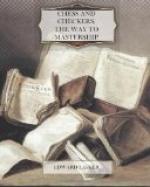Frequently a sacrifice is brought to maintain a pin which is bound to yield a piece in return sooner or later. The position of Diagram 37 is typical for cases of this kind.
+---------------------------------------+ 8 | #R | | #B | #Q | | #R | #K | | |---------------------------------------| 7 | #P | #P | #P | | | #P | #P | #P | |---------------------------------------| 6 | | | #Kt| #P | | #Kt| | | |---------------------------------------| 5 | | | | | #P | | ^B | | |---------------------------------------| 4 | | #B | ^B | | ^P | | | | |---------------------------------------| 3 | | | ^Kt| ^P | | ^Kt| | | |---------------------------------------| 2 | ^P | ^P | ^P | | | ^P | ^P | ^P | |---------------------------------------| 1 | ^R | | | ^Q | | ^R | ^K | | +---------------------------------------+ a b c d e f g h
Diagram 37.
Supposing Black plays (1) ..., P-h6; (2) B-h4, P-g5 to free himself of the pinning Bishop. Then White can sacrifice the Knight f3 for the two black Pawns and thereby maintain the pin with the threat to regain the Knight immediately through Kt-d5. The ensuing play could be the following: (3) Ktxg5, Pxg5; (4) Bxg5, Bxc3; (5) Pxc3. Now White threatens to play P-f4 and Pxe5 opening the line of his Rook and thereby attacking the pinned Knight for the second time. This threat cannot be effectively countered. Black could try to unpin the Knight by (5) .... K-g7; (6) P-f4, Q-e8. Indeed, Black saves his Knight in this way, but the exposed position of his King leads to a speedy disaster. For instance: (7) Pxe5, Kt-h7; (8) B-f6+, Ktxf6; (9) Pxf6+, K-h7; (10) Q-h5+, K-g8; (11) Q-g6+, K-h8; (12) Q-g7+/-. Black could not take White’s Queen on the 11th move because the Pawn f7 was pinned by the Bishop c4.
If Black had moved his King to g8 or g6 on the 8th move instead of taking the Bishop f6, White would have forced the mate by sacrificing his Rook on f5, thereby cutting off the Bishop c8 and giving his Queen access to the square g4.
Sacrifices with the view to utilizing a pin occur in various other versions which are essentially different from the one illustrated above. Following are typical examples of the three most frequent cases.
In the position of Diagram 38 Black must not take the Pawn e4 although he can protect the Knight with B-f5 in case White pins him with R-e1.
+---------------------------------------+ 8 | #R | | #B | | #K | | | #R | |---------------------------------------| 7 | #P | #P | | | | | #P | #P | |---------------------------------------| 6 | | | #P | | | #Kt| | | |---------------------------------------| 5 | | | | | | | | | |---------------------------------------| 4 | | | | | ^P | ^Kt| | | |---------------------------------------|




